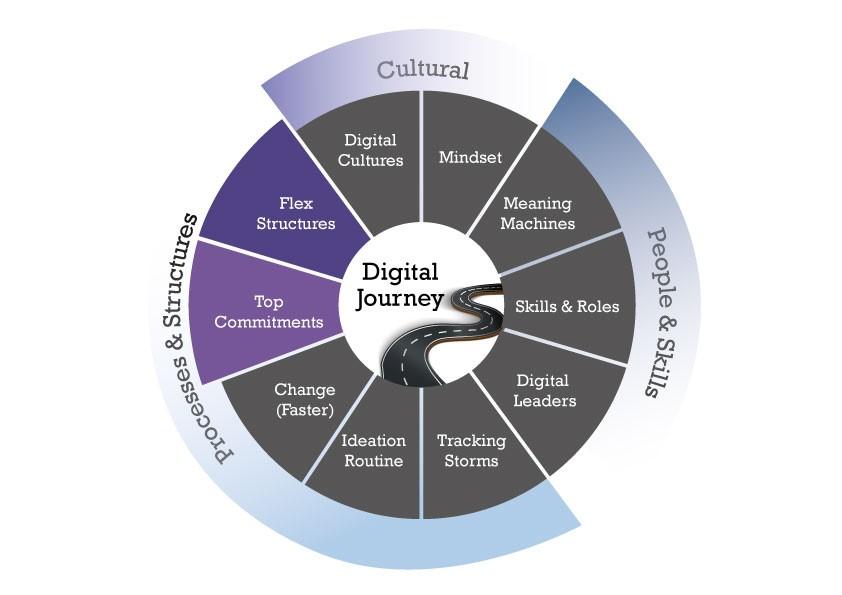
This is the fifth article in our special series on the Digital Journey.
We regularly hear that digitisation efforts have to be driven from the top. They need management attention and an end-to-end plan that makes digital part of the organisational DNA. But what this actually means is rarely articulated. The structural arrangements companies make to digitise are as important as the decision to follow a path of digitisation in the first place.
As we discovered in interviews with executives at the forefront of the digital journey for a recent research article, digitisation often starts in small pockets, special teams or special units (often in IT departments, for better or worse). But these efforts are unlikely to become part of the core business until management sets some clear, high-level policies and structures (i.e. fully connected to line management).
The problem with budding digital projects is that they often lack legitimacy, power and integration with the core business. Therefore, concrete strategic commitments need to be made from the top that allow these pockets of growth to scale and become part of the firm’s core operations.
If we take e-books as an example, one of our interviewees from a large global publishing house told us: “Publishers were not positive about e-books… They didn’t think it was going to make them a lot of money, which it didn’t initially.” More importantly, it wasn’t part of their scorecard and incentives. It took substantial (widespread) changes in top management incentives and the creation of a common policy on how to deal with agents and authors, for electronic books to really take off in this organisation: “There was a certain tipping point where they just started accepting this as another format.”
The point is that digital changes can be disruptive internally, impacting in fundamental ways how people interact and do their job. This will usually have knock-on effects, with implications for various structures (incentives, decision processes, linking mechanisms, customer policies), all of which need to be examined and possibly modified.

The evolution of digital structures
While this example shows how top-down commitment enabled a digital initiative to become part of the core business, our study also gave us an overall impression of how digital structuring may proceed on the whole.
1. Small is beautiful
As noted, these projects often start small. This can also mean that they may be numerous and eventually require consolidation.
2. Centralisation
Eventually, some rationalisation or centralisation of things digital may be necessary. As one manager recounted: “There were a few teams in one of the product lines that did digital product development and technology. We had many different pieces, and they were all very small and they had no management with a digital focus. We centralised it in one big team.”
3. Integration: Making it core
As single digital initiatives develop, scaling their impact requires integrating them back into the core business. However, this can be done in several ways. There is no single best way to integrate digital with the legacy business – it all depends on the context.
A. Legacy adopts digital One path is for the core, pre-existing business to simply pull in the digital business. If we return to e-books, another interviewee told us that digital belonged to IT in the very beginning: “Then we created a specialised e-book department with an e-book salesperson, e-book production, e-book strategy.” Eventually, all of this work was “decentralised” and placed within each of the respective (core or legacy) publishing units: “The producer of print is now responsible for doing e-books as well.”
B. Digital adopts legacy Alternatively, the digital business – which may be scaling rapidly – can become the central unit (or power centre) and absorb parts of the legacy business. Ultimately, the adopting unit may vary even within a business line. For example, one interviewee in magazine publishing said that digital products at his firm started as a distinct business entity with separate leadership, adding: “That’s now changed. These two spaces are more and more consolidated and we have certain verticals where these things come together again.” In the case of one brand, the legacy publisher is now in charge of both print and digital, while for another brand, the digital business director is helming both sides – a good example of how digital is growing faster and is probably “more future-proof”, in the words of the interviewee.
4. Matrix structures
Finally, in some situations, both units may be strong and viable on their own (at least for now). Some form of matrix structure may then be required to reduce redundancies and ensure idea and innovation sharing. This includes maintaining some central digital units (e.g. digital marketing, digital technology development), accessible to all.
While not exhaustive, our interviews shone light on the possible paths organisations can take on their digital journey to scale digital experiments and eventually integrate them. The key is being flexible with structures and letting them evolve to keep pace with the opportunity. As explained in the previous article of this series, digital change can create resistance. One needn’t look far to see the challenges of matrix organisations, for example.
Making digital initiatives part of the company operations is one thing. Making them part of the culture is quite another. In my next and final article in this series, I will examine the tensions that arise in developing a digital culture, which emerged as the most persistent and common challenge our interviewees described.
Charles Galunic is a Professor of Organisational Behaviour and the Aviva Chaired Professor of Leadership and Responsibility at INSEAD.





Anonymous User
14/12/2017, 10.08 pm
A very insightful article Professor!
I feel that in the mad rush to "digitize" or "e-enable" services and processes the management is driven more by the neighbour's envy than by actual need!
The scale of automation, digitization and all things "e" should be decided carefully before throwing a spanner in the works and creating chaos across the orgnisation.